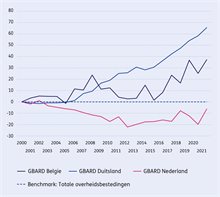Want to know more?
Read more about TNO Vectors analysis into the Netherlands' R&D investment backlog.
TNO Vector cannot make policy itself – that’s up to the government. What we can do, though, is identify certain trends on the basis of research and raise the alarm if we see any developments that might have an adverse effect on the country’s innovative capacity. And in terms of current R&D spending, there is every reason why alarm bells should be ringing.
A telling picture
Sometimes line graphs help us to visualise a problem at a glance. And this is certainly the case with a graph that recently featured in a paper by TNO Vector (see Figure 1)

Figure 1: Development in government budget allocations for R&D (GBARD) from 2000 in the Netherlands, Germany and Belgium relative to the development of total public spending. The difference was obtained by subtracting the normalised total government expenditure from the normalised GBARD
Our special thanks go to Jasper van Kempen, who produces economic analyses at TNO Vector, particularly on how government actions affect the market. How did he come up with the idea of showing how public R&D funding has changed relative to government spending in a single graph?
‘In a publication last year, the Fiscal Space working group recommended that the Netherlands should start making €17 billion of cuts from 2028 to reduce the risk of too high a deficit. Together with colleagues, I wondered what that would mean for R&D spending. And in doing so, we immediately asked ourselves how we were doing in the Netherlands compared with Germany and Belgium. The data needed was already available, but it was still a challenge to compare the right things with each other and display them in a clear way.’
Belgium way ahead of us
‘The fact that Germany is doing much better than the Netherlands was not really a surprise,’ he continues. ‘But the fact that Belgium is doing so well in terms of R&D spending did come as a surprise. In fact, they are number one in Europe in terms of R&D funding.’
Unlike the Netherlands, Belgium has very consistently invested more in R&D since 2000, when both countries were at the same level, so it is now way ahead of us. Spending 3% of GDP on R&D was also the Netherlands' target for the same period.
But we just didn’t take the necessary action. And with more and more talk of austerity again, it remains to be seen whether more money will be allocated to R&D in the coming years.’
Distorted picture
‘Unfortunately, that’s not looking likely,’ says Marcel de Heide, an economist at TNO Vector researching innovation policy. ‘For instance, we can see that the National Growth Fund is currently under pressure. But if that initiative comes to an end without anything to take its place, we in the Netherlands will fall behind even further in terms of R&D spending.
Meanwhile, there is a widespread perception in our country that we are actually doing incredibly well in terms of innovation. But that’s because the focus is always on a few top performers, such as ASML, creating quite a distorted picture.’
For the long haul
The fact that R&D spending within our country is structurally insufficient could cause serious problems in the longer term, according to De Heide.
‘It is difficult to express the ROI of R&D in hard figures. But we do know from several studies that there is a clear relationship between research and a country's earning power in the longer term.
So, when it comes to R&D, the costs always outweigh the benefits, and you need to be in it for the long haul. That also means that when you fall behind, it will take a long time to get back up to the level you want. Even standing still in today's world means you quickly lose a lot of ground.’
Tough choices to be made
It is true that you’ll feel the pinch when spending big on R&D because you cannot reap the benefits straight away. De Heide is also aware of this, of course.
‘But everything points to the fact that we in the Netherlands are going to miss the boat if we fail to radically revamp our economy in time. Just continuing as we always have done is really no longer an option at this point.
That means tough choices will have to be made to ensure enough money is spent on R&D to move rapidly towards 3% of GDP, even when national debt is increasing.’
National Technology Strategy
What about the government, which is all too aware of the problem? The Ministry of Economic Affairs recently launched the National Technology Strategy focusing on 10 up-and-coming technologies. The plan is to find private financiers willing to invest with the government in driving the chosen technologies.
‘At TNO Vector, we obviously welcome that initiative,’ De Heide responds. "But success will largely depend on the amount of money the government itself will dedicate to this plan. Research shows that the private sector is willing to invest in innovation projects if the government shares the R&D costs... the well-known multiplier effect.
But because these are political choices, it is very difficult to make predictions at the moment. Meanwhile, the clock is ticking, so we hope that there will be more clarity on the government's exact R&D policy soon.’





